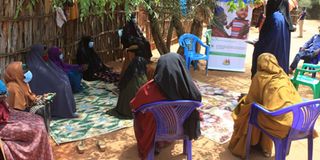Breaking News: At least 10 feared to have drowned in Makueni river
Red alert: Colour-coded tape keeps children from malnutrition in Mandera

Women at Eymmole village in Mandera during a support group meeting in the war against malnutrition.
In villages, health centres and homes across Banisa, women are learning how to fight malnutrition, one of the biggest challenges Mandera County faces.
At Emey village, Saadia Ali is at her home waiting for other women to arrive for the day’s session. “It is my turn to host our women group that deals with good feeding, a programme introduced to us by Action Against Hunger almost a year ago,” she says.
Saadia’s is one of the several women groups in Mandera armed with knowledge on how to fight malnutrition.
A 2019 nutritional survey by the Mandera County government indicates an acute malnutrition rate of 22 per cent, and a severe acute malnutrition rate of four per cent, signalling a critical situation.
Half of the children under the age of five in Banisa are stunted, which means they are not getting the nutrients they need to grow and develop.
Low birth weight
Fatuma Ibrahim also leads a group of women who are learning how to diagnose malnutrition and cook healthy food for themselves and their children to give them the best possible start to life. “We meet to teach each other on the consequences of poor nutrition and inadequate nutritional intake for women during pregnancy. We are supported by community health volunteers, and for the past one year, things have been changing,” she says happily.
Fatuma says poor nutrition does not only directly affect women’s health, but also has a negative impact on birth outcomes and early development for their children.
“Traditionally, our staple foods are camel milk, meat and rice, which we have realised are not the most healthy options. We are now cooking beans, ugali, eggs and even green vegetables in our homes,” she adds.
Several research findings have shown gestational malnutrition leads to low birth weights and may ultimately culminate in poor child growth and development, thus there is an urgent need to address high rates of malnutrition among pregnant women.
In Banisa, most households lack enough food.
At these weekly gatherings, women are trained on caregiving for pregnant women and good breastfeeding.
The mid-upper arm circumference (Muac) is the game changer here. It is simply a tape with three colours: red, yellow and green, which are used to indicate levels of malnutrition, according to Mohamed Madey, Banisa Sub-County nutritional officer.
Twins status
He explains that any measurement falling under red means the child is critically malnourished. A yellow stripe indicates moderate malnutrition and green is a sign of a stable nutritional status.
“We are trained on how to observe our children’s health using the family Muac tape. As soon as we spot a problem, we go to a health facility or outreach centre for nutritional support,” says Fatuma.
At the health centres, the workers use a different type of tape that is well calibrated with numbers and colours. “Muac is helping to detect malnutrition. The affected children are admitted into Supplementary Feeding Programme and Out Patient Therapeutic programmes,” says Mohamed.
At Burushum village, south of Banisa, Adoy Hassan, 30, and a mother of eight is closely observing the health status of her twins.
The twins, Meymuna and Naima were diagnosed with acute malnutrition in June. “My twins have been in this programme for three months and I am seeing a difference in their body condition,” says Adoy.
Due to persistent drought, she was unable to provide a balanced diet for her family, resulting in her children’s malnutrition. “They were only fed on camel milk then, but with the food supplement, they are improving as I continue to provide a balanced diet at home,” she says.
Anaemia concerns
Mohamed Abdishakur, a nutritional expert, notes that access to health and nutrition services is a challenge for most residents of Mandera since health facilities are far apart.
The nearest health centre to Adoy is at Darkale, some 30km away, leaving her to rely on health outreaches that are conducted at least twice a month.
At least 51 integrated health outreaches have been supported under the Action Against Hunger’s Integrated Emergency and Recovery Response programme for vulnerable communities affected by drought in Mandera.
Major factors contributing to high levels of acute malnutrition in the county include poor childcare practices, inadequate access to child survival interventions and poverty.
Others are unavailability of diversified nutritious foods particularly fruits and vegetables in rural areas and poor feeding practices.
According to surveys in the county, adolescent girls and women also experience high rates of anaemia due to poor nutrition.



